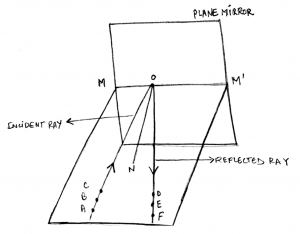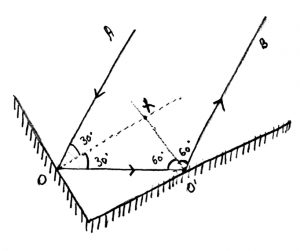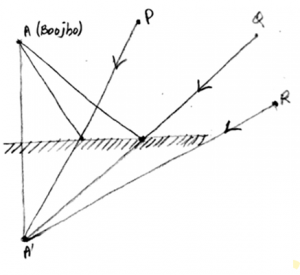NCERT Solutions for Class 8 Science Chapter 16 Light, contains solutions to various questions in Exercise for Chapter 16. At the end of the Solutions, all the keywords and Notes which are important to understand Science Chapter 16 Light, have been explained in a simple and easy-to-understand manner. NCERT Solutions for Class 8 help to check the concept you have learned from detailed classroom sessions and the application of your knowledge.
| Category | NCERT Solutions for Class 8 |
| Subject | Science |
| Chapter | Chapter 16 – Light |
Download NCERT Solutions for Class 8 Science Chapter Chapter 16 Light
NCERT Solutions for Class 8 Science Chapter Chapter 16 Light – NCERT Exercises
Question 1
Suppose you are in a dark room. Can you see objects in the room? Can you see objects outside the room. Explain.
Answer 1.
When we are in a dark room, we cannot see the objects inside the room. We can only see objects from which reflected light enters into our eyes. That is also the reason why we are able to see the objects outside our room from where the light is coming after being reflected.
Question 2
Differentiate between regular and diffused reflection. Does diffused reflection mean the failure of the laws of reflection?
Answer 2.
| Regular Reflection | Diffused Reflection |
|---|---|
| It takes place on a smooth and shiny surface | It takes place on a rough or irregular surface |
| In this case, the reflected rays are parallel to each other | In this case, the reflected rays are in the different directions |
Question 3
Mention against each of the following whether regular or diffused reflection will take place when a beam of light strikes. Justify your answer in each case.
(a) Polished wooden table
(b) Chalk powder
(c) Cardboard surface
(d) Marble floor with water spread over it
(e) Mirror
(f) Piece of paper
Answer 3.
(a)Regular reflection will take place because it is polished so it is a smooth surface.
(b)Diffused reflection takes place because chalk powder is rough in nature.
(c)Carboard surface is rough in nature so irregular reflection takes place.
(d)Regular reflection takes place because it acts like a plane surface.
(e)Regular reflection takes place as its surface is shiny and smooth.
(f)A piece of paper has tiny irregularities in it so irregular reflection.
Question 4
State the laws of reflection.
Answer 4.
The laws of reflection states that:
- The angle of incidence is always equal to the angle of reflection
- The incident ray, reflected ray and the normal on the point of incidence all lie in the same plane
Question 5
Describe an activity to show that the incident ray, the reflected ray and
the normal at the point of incidence lie in the same plane.
Answer 5.
For this experiment take a plane mirror and stand it on a plane sheet of paper with a block. Now we draw an incidence line AB. Now we see in the mirror and mark the points on the paper, where we find the line is travelling after getting reflected from the mirror. After this, remove the mirror and draw a perpendicular line on the mirror line. Join the points to make the reflected ray. Then you will see that incident ray, reflected ray and normal will be in the same plane, i.e. on the sheet of paper A,B,C,D,E and F are the pins used to mark the points.

Question 6
Fill in the blanks in the following :
(a) A person 1 m in front of a plane mirror seems to be ________ m from his image.
(b) If you touch your ______ ear with right hand in front of a plane mirror it will be seen in the mirror that your right ear is touched with _______.
(c) The size of the pupil becomes _______ when you see in dim light.
(d) Night birds have _______ cones than rods in their eyes..
Answer 6.
(a) A person 1 m in front of a plane mirror seems to be 2m from his image
(b) If you touch your left ear with right hand in front of a plane mirror it will be seen in the mirror that your right ear is touched with left hand.
(c) The size of the pupil becomes large when you see in dim light.
(d) Night birds have more cones than rods in their eyes.
Question 7
Angle of incidence is equal to the angle of reflection
(a) Always
(b) Sometimes
(c) Under special conditions
(d) Never
Answer 7.
(a)Always
Question 8
Image formed by a plane mirror is
(a) virtual, behind the mirror and enlarged
(b) virtual, behind the mirror and of the same size as the object
(c) real at the surface of the mirror and enlarged
(d) real, behind the mirror and of the same size as the object.
Answer 8.
(b)Virtual, behind the mirror and of the same size as the object
Question 9
Describe the construction of a kaleidoscope.
Answer 9.
A kaleidoscope is made by arranging two or more mirrors at some angle to each other usually forming a triangle. Three mirrors are placed inside the hollow triangular tube and their reflecting surfaces face each other. One end of the tube is covered with a transparent sheet while the other end is covered with an opaque sheet. Small pieces of glass are kept inside the tube and there is a pinhole at the opaque side. When the kaleidoscope is turned, we see the different images in it due to the reflections inside it.
Question 10
Draw a labelled sketch of the human eye.
Answer 10

Question 11
Gurmit wanted to perform Activity 16.8 using a laser torch. Her teacher advised her not to do so. Can you explain the basis of the teachers advise?
Answer 11
In activity 16.8, we throw a laser light in the eye of our friend in order to see the size of his pupil. However, the laser light used is of very high intensity and can cause damage to the human eye even leading to blindness. That is why Gurmit was not allowed to perform the experiment.
Question 12
Explain how you can take care of your eyes.
Answer 12.
We can take care of our eyes by the following ways:
- We should wash our eyes at least three times a day with cold clean water
- We should not touch our eyes with dirty hands
- We should look at the television, laptops etc. from a suitable distance
- We should not rub our eyes
- We should use spectacles if we have problem in reading
- We should consult an eye specialist after every six months
Question 13
What is the angle of incidence of a ray if the reflected ray is at an angle of 90° to the incident ray?
Answer 13
The angle of the incidence ray should be 45 degrees from the normal
Question 14
How many images of a candle will be formed if it is placed between two parallel plane mirrors separated by 40 cm?
Answer 14.
Infinite images are formed when two plane mirrors are placed parallel to each other irrespective of the distance where they are placed.
Question 15
Two mirrors meet at right angles. A ray of light is incident on one at an angle of 30° as shown in Fig. 16.19. Draw the reflected ray from the second mirror.
Answer 15.

Question 16
Boojho stands at A just on the side of a plane mirror as shown in Fig. 16.20. Can he see himself in the mirror? Also can he see the image of objects situated at P, Q and R?

Answer 16.

Boojho cannot see his own image. He can only see the image of P and not Q and R.
Question 17
(a) Find out the position of the image of an object situated at A in the plane mirror (Fig. 16.21).
(b) Can Paheli at B see this image?
(c) Can Boojho at C see this image?
(d) When Paheli moves from B to C, where does the image of A move?
Answer 17.
(a)The image of A is formed behind the mirror at the same distance as much as A is in front of the mirror
(b)Yes, Paheli at B can see this image
(c)Yes, Boojho at C can see this image.
(d)When Pahelimovees from B to C then the image of A is not affected. It will remain at the same place.
Topics Covered in Chapter 16 Light System Class 8 Science :-
- What makes Things Visible
- Laws of Reflection
- Regular and Diffused Reflection
- Reflected Light Can be Reflected Again
- Multiple Images
- Sunlight — White or Coloured
- What is inside Our Eyes?
- Care of Eyes
- Visually Challenged Persons Can Read and Write
- What is a Braille System?
Important Terms Relevant to understand NCERT Solutions for Class 8 Science Chapter 16 Light
Incident ray: The ray of light which strikes any surface is known as the incident ray.
Reflected ray: The ray of light which comes back after reflection from the surface is known as the reflected ray.
Normal: An imaginary line that is perpendicular to the incident reflecting surface
Law of reflection: The angle of incidence is always equal to the angle of reflection. The incident ray, reflected ray and the normal on the point of incidence all lie in the same plane.
Lateral inversion: When the left side of an object appears on the right and vice versa such as when looking in a mirror, it is known as lateral inversion.
Diffused reflection: The reflection from an irregular surface which results in diffused reflected rays of light
Regular reflection: The reflection of the parallel rays of incident light from a smooth surface is called regular reflection.
Dispersion: The phenomena of the splitting of white light into its constituent colours
Blind spot: The junction of the optic nerve and the retina where there are no sensory cells is called blind spot.
NCERT Solutions for Class 8 Science
- Crop Production and Management
- Microorganisms: Friend and Foe
- Synthetic Fibres and Plastics
- Materials : Metals and Non-Metals
- Coal and Petroleum
- Combustion and Flame
- Conservation of Plants and Animals
- Cell Structure and Functions
- Reproduction in Animals
- Reaching the Age of Adolescence
- Force and Pressure
- Friction
- Sound
- Chemical Effects of Electric Current
- Some Natural Phenomena
- Light
- Stars and The Solar System
- Pollution of Air and Water